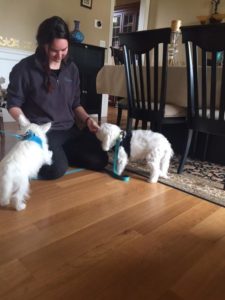Last week we discussed the pros and cons of working with pets individually vs. with multiple at the same time. Check it out here if you haven’t yet read that post. Now that you’ve considered if you should be working with an individual pet vs. your whole crew, let’s get into the details of how to make that possible.
Working individually
I observe body language for a living: canine, feline, and human. Often when I make the recommendation to someone to work with one of their pets individually, I’m met with a look of apprehension. Sometimes that apprehension stems from time or worrying about not being fair to another animal, but sometimes it’s because they’ve tried it before and it didn’t work well for them. In those cases, the client usually describes to me that their other pet– the one left alone– spent the entire time barking or scratching at the door. I can understand the apprehension of trying it again if that was the case before!
When this happens and it’s not a matter of separation, isolation, and/or confinement anxiety, then I recommend to my client to give the other pet something really awesome to work on while they’re alone: stuffed Kong, bully stick, food puzzle, etc. If that doesn’t work, we can work on building duration with the other pet in the separated room. If it is a matter of separation, isolation, or confinement anxiety we can work through a behavior modification plan to address those more serious behaviors.
Working with multiple pets simultaneously
There are a number of ways to be successful at this task and each situation may look a little different depending on the specific needs of the animals and what you’re working on. Here are some tips for working with multiple pets at the same time (but know that there are other options out there than just these!):
Many hands make light work
So often I hear that people are worried about two animals trying to take the same treat at the same time and a fight ensuing. In that case, if your pets don’t yet have a great “wait” behavior, treat each simultaneously from two hands like in the picture below.

You can also get additional help from others. Have 4 animals? Get 4 hands into the training mix. This can help with letting you focus on your particular task, too, if you’re working on growing your animal training skills. Many hands really do make light work in this case.
Baby gates can help improve safety
As I mentioned in the post about how Covid-19 is impacting behavior (read it here), I have a lot of clients at the moment currently working on dog-dog interactions within the house. I’ve seen a significant uptick in dogs having trouble living with one another and I know some of my colleagues have mentioned seeing the same trend. In those cases, we will eventually need to work with the dogs in relatively the same space. We’ll also need to make sure we do so carefully and safely.
We can absolutely have both dogs on leash (and for those of you working on dog/cat relationships, we often get the cat comfortable wearing a harness and leash, too!) with two handlers. That said, it becomes trickier when we need to rely on multiple people’s schedules to work on the pets’ relationship. This is where baby gates can be incorporated.
Set up a baby gate so that you can work with one pet on one side and one on the other. This usually brings some peace of mind to the humans as well which can make the session more fun for everyone. If having pets on just one side of the baby gate is still too close for them, then you can set up two gates with however much “dead space” you need in between, kind of like an airlock:

Stationing
The last technique we’ll talk about here is stationing: teaching a pet to go to a particular place and hang out there. Sometimes trainers will refer to this as place work, mat work, or something similar. With stationing you can have one animal on a mat or bed out of the way while working with another, then switch them. This is a more advanced approach in that you need to be able to focus on the animal in front of you but also keep whoever is stationing in mind and reinforcing each appropriately. I tend to give a treat to the stationing animal whenever I treat the one I’m currently focusing on.
This is a regular technique used in zoos where it’s more challenging to separate animals for training. Regardless of your feelings about zoos, many do a wonderful job of training their animals– usually to safely participate in husbandry and medical procedures– and can be a good place for inspiration of what’s possible with training.
Check out this video showing crocodiles training and stationing from the Wildlife Conservation Society and Bronx Zoo:
It’s often easier to teach animals to station separately before bringing them together. A professional trainer can help you with this process; it will need to be well-proofed, especially if you have trouble keeping a high rate of reinforcement (aka how frequently you treat).
Now what?
- Try your hand at training multiple animals at once. Choose one of the above options to start with.
- Practice whichever option you choose before bringing your pets into the mix. Practice doling out treats single-handedly. Teach stationing separately. Practice splitting your attention between observing multiple individuals at a time. Whatever you choose, it will be easier for you and less frustrating for your pets to practice without them first.
- Start short and sweet. Work with your pets just a minute or two at a time. Assess how it went and how it can be improved on then try again for another minute or two.
- Consult with your professional trainer or behavior consultant– especially if there are safety concerns between the pets. A professional can help you fine tune your skills, your pets’ skills, and help you keep everyone safe during the training process. Email us at [email protected] to be paired with a consultant and set up your first session.
Happy training!
Allie
